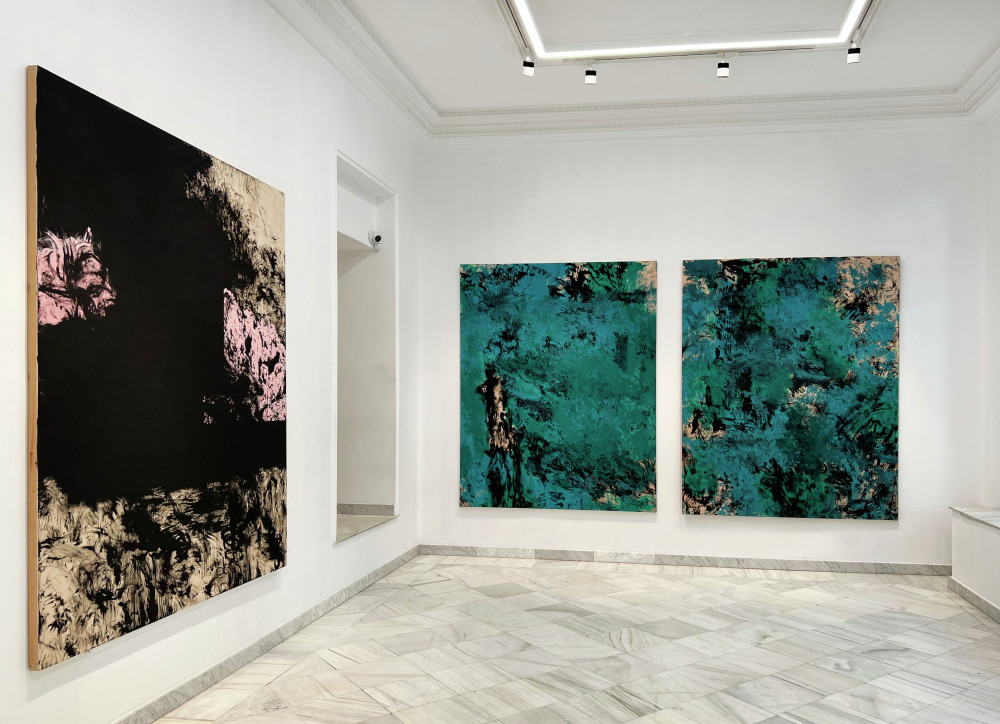
CARLOS LEÓN. Encender
08 Sep - 24 Oct 2022
The Fernando Pradilla Gallery presents the third individual exhibition of the Spanish artist Carlos León (Ceuta, 1948). This project, titled Encender [Light Up], organized in the context of Apertura 2002, collects a number of recent works that use wood as their primary format, a surface whose plastic possibilities he has been investigating since 2019, leaving behind almost twenty years of a career wholly dedicated to experimenting with oil painting on dibond. The return of acrylic, spread across the wood by hand or by means of a broad brush, allows León to create complex chromatic compositions, endowed with a pictorial calligraphy where the traces of his body over the surface remain the protagonists of these new medium- and large-size paintings.
Háfrika and Jardín Químico are two of the series that make up the central axis of this exhibition, where Carlos León picks up on themes previously touched in his artistic oeuvre, associated, in this instance, to new personal ideals and lived experiences. In the former he speaks of social destitution and, at the same time, of the rich culture of the continent that presided over his birth. The orthographic anomaly of this series, as the author explains, reflects his desire to rewrite the word Africa, introducing phonetic elements, such as the aspirated H and the letter k, which belong to some of the most widespread languages and the local dialects of that continent. For Carlos León, who was born in Ceuta and has traveled on multiple occasions through its geography, Háfrika constitutes, no matter where you look at it from, a fascinating inspiration. Its painful history, branded by the brutal experience of slavery and absuvie colonialism, seems to have been unable to efface or sterilize the depth of its cultures, its religious beliefs, and the admirable vital attitude of its inhabitants. Confined to his studio as a result of the recent pandemic, Carlos León explores once again the deepest and most intimate nature of the hafrikan, paying homage to the expressive power of this continent through abstraction and essentiality.
In the works that make up the series Jardín Químico, an acid-hued green stands out above all else; a tonality which is not found in nature, one which formulates a question about our actions on this planet, touching, thus, one of the most important problems which are not only affecting the ecosystem, but our very lives and our customs. The garden, understood as a symbolic and representational space, is the motif upon which Carlos León has built a large swath of his work from the 1980s onwards. After his prolonged years in Paris in the 1970s, where the axioms and aesthetic principles of the Suport-surface movement became an essential groundwork for his production, Carlos León begins, from his second international period, this one with residence in New York, to incorporate into his pieces certain parameters drawn from action painting, leaving behind his paintbrush to step forth with a gestural and primitivist form of painting where the direct action of the body over the surface becomes the constitutive plastic and conceptual element which defines his current language.
Carlos León has garnered the acclaim of critics, museums and public institutions, both public and private. He has been awarded the Community de Madrid Prize for Plastic Arts in 2014 and the National Art and Patronship Prize by the Fundación La Caixa in 2016. In the last few years his work has been exhibited in numerous institutional exhibitions such as the José Guerrero Art Center in Granada: “Pasajes” (2018) curated by Francisco Baena; “Tomando distancia” (2020) at the Contemporary Art Center of Málaga, and “Fracturas” (2021) at the Domus Artium of Salamanca, curated by Fernando Castro Flórez.
His work is represented in a great number of private and public collections, among them the collection of the Museo Nacional Centro de Arte Reina Sofía MNCARS; Fundación Suñol Collection, Barcelona; Banco de España Collection; Citibank Collection, Madrid; Helga de Alvear Foundation Collection, Cáceres; Bilbao Fine Arts Museum; Caja Madrid Collection; Patio Herreriano Contemporary Spanish Art Museum, Valladolid; and the Castilla y León Museum of Contemporary Art, MUSAC.






